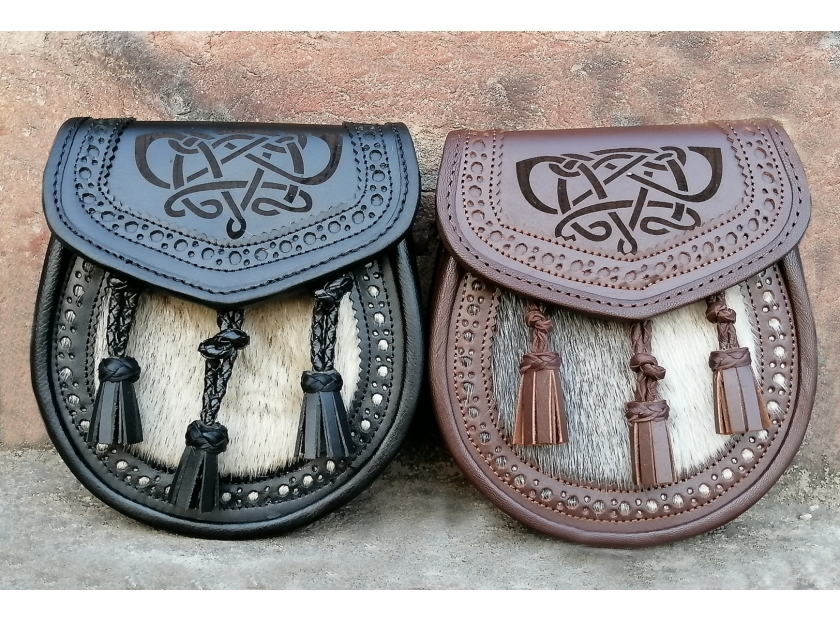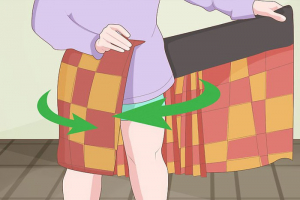Brief Introduction About Sporran
Posted:
February 13, 2022
A sporran is a firm pouch made of calfskin and, depending on the type of sporran, storage, skin, fur, and hair. Its aspects, depending on the type of sporran, are approximately 60 cm by 40 cm. The back and pleat (or cover, as designer sporran will call it) are cut from a single piece of calfskin; the front of a later piece. A calfskin gusset is then sewn to the back and sewn to the front. The back pleat then twists around the top and is secured in the front with a peg or latch.
The overwhelming majority of sporrans additionally have tufts joined at the front. In a pure calfskin sporran, such as a 'day sporran', the decorations, normally 2 or 3, are threaded directly into the front piece. For additional invigorating sporrans, for example "dressed" or "semi-dressed" sporrans, the tufts, up to 6, are secured with small enhancement chains, which hang directly or crosswise from the front piece. Hair, fleece or skin decorations are bound with pewter, chrome or silver heads before being connected to the chain.
In today's sporrans, you'll find the calfskin interior secured with delicate, softened cowhide. There may be a key ring that you can hang your keys on and separate pockets for your Mastercards and coins. Some even have a small pocket in which you can slip your cell phone. As we like to say, a sporran is awesome stuff!
Types of Sporrans
There are five main types of sporran:
A daytime sporran, or sometimes a casual or just leather sporran, is very common and the one you wear, well, during the day. It is made entirely of leather and is traditionally black, although it is now common for leather to be offered in different shades such as brown, beige or grey. Being a simple daytime sporran, it is usually plain leather with no embellishments, but can sometimes also have elaborate Celtic designs embossed on the lid, either etched or - more common these days, from a laser. Sometimes the pattern is in the form of small pewter or chrome studs. In many ways, the daytime sporran is the modern equivalent of the original sporran of yore - a simple leather pouch made up of three pieces of leather sewn together. The back of the sporran is almost twice as long as the front of the sporran and curves over the front to form the flap, or lid, as the sporran maker calls it.
The formal sporran. The one you would wear to a big event, like a wedding. Unlike a daytime sporran, it has no flip top and opens from the top. The front of the sporran robe is usually leather, hide or fur. The sporran dress also has a pewter or silver decoration around the top of the front called a cantle, which can be richly decorated and designed. The cantle has a stud at the top which is used to hold the sporran open or to close it. It is kept closed by a small strip of leather holding the front to the back and closed by a press stud.
The intermediate sporran. Wear it to a wedding or casually if you like. It is constructed like the daytime sporran, with the back of the sporran longer than the front and forming the flap or lid that encloses the sporran. The lid is also richly decorated with Celtic badges, studs and reliefs. And like the sporran robe, it has a front of leather, fur, or skin, and has at least three tassels that hang from straight or crossed decorative chains.
This type of sporran is made from leather and animal fur. The fur is sewn on the front and the pom poms, usually 2 or 3, are also made from the fur. Fur sporrans are available in fox, beaver, rabbit, musquash, lamb, coyote, highland cow, and mink. There's even a skunk sporran! Typically luxurious to the touch, they are a type of sporran dress and always feature a richly decorated cantle. An extension of the animal skin sporran uses the animal's head as a flap. Sometimes called full-mask sporrans, they come in musquash (muskrat) or fox (road-harvested) form. Although not made with tassels, they are used as clothing sporrans.
As we have seen, horsehair is widely used for regimental and bagpipe sporrans. By the way, hair is not collected from dead horses. It is collected by grooms in stables as soon as the horse's tail is combed, then checked for disease before being sent in long tubes to the sporran maker.
History of Sporran
The earliest sporrans were simple affairs, being a leather pouch, probably of buckskin, closed with a cord and fastened by a strap to the waistband which held the feileadh-mhor or "great kilt" in place. It was basically a handbag that was worn with a kilt.
Similar pouches were once worn by people across Europe, but as they were replaced by pockets in trousers or by smaller wallets or purses that were kept in pockets, in Scotland the sporran stayed. After all, we still wear kilts. And no one has yet invented a kilt with a pocket!
The name, sporran by the way, comes from the Scottish Gaelic word sporan which means purse or wallet or kilt pouch.
Materials for Sporran
At their core, sporrans are simple affairs and are only made from a few materials.
- Leather
The basic material of a sporran is leather. Some sporrans, such as the daytime sporran, as we have seen, are made entirely of leather. Inside the sporran, the leather is often covered with suede.
- Metal
Pewter, chrome and silver (and gold if you can afford it) are used for the cantle of regimental costumes and tartans. They are also used for the pom pom head which is then attached to the chain which holds the pom pom to the front of the sporran. Stainless steel links are used as part of the leather strap used to tie the sporran around the waist.
- Animal skins and hides
Clothed sporrans use hide, skin, or fur for the front of the sporran and may even sometimes use the animal's head. Foxheads and Musquashheads are the most common to watch out for. (Fox heads are only picked up on the road and are therefore quite rare.) The front of a sporran robe was traditionally made from sealskin, but this was banned in Europe in 2009 after a blanket regulation banning the use of seal products. However, the ban was amended in 2015 to allow traditional Inuit hunting of seals and sealskin can once again be found on sporrans.
- Horse mane
As we have seen, horsehair is widely used for regimental and bagpipe sporrans. By the way, hair is not collected from dead horses. It is collected by grooms in stables as soon as the horse's tail is combed, then checked for disease before being sent in long tubes to the sporran maker.
How to Wear a Sporran
A sporran is worn around the waist and should sit in front of the groin, i.e. not too high and certainly not too low on the kilt. If you are unsure, then a good way to determine where the sporran should sit is to place the top of the sporran a hand's width from the top of your kilt. If you feel it bouncing too much while you're dancing the reel of eight, then hoist it through a few strap holes while you're on the dance floor. You can always drop it again. Or twist it around and hang it on your hip.
If you wear a horsehair sporran it is usually fastened so that the bottom of the sporran does not extend past the hem of the kilt - although if you've seen old photos of Scottish soldiers in kilts wearing their regimental horsehair sporrans , you'll see some extending well beyond the hem of the kilt!
Keep in mind that your sporran is both practical and decorative - it's meant to be seen. And if it looks good and feels good, then it's probably hooked up too. Of course, some sporrans are more ornamental than others, nor are the horsehair sporrans worn by Scottish regiments - and of course by pipe bands around the world.
Use of Sporran
Originally, sporrans were just buckskin pouches, held closed by a drawstring and hung from a belt that hung around the waist or over the shoulder. In the sporran, the wearer would keep essential things for the day. Food maybe, a little money if he had it, ammunition if he had a gun. But not a knife. Knives were too long to keep in sporrans and would take far too long to retrieve if needed quickly (this is why you see a knife (called sgian dubh) sticking out of men's socks when they wear the kilt But that's another story.
Now, in our sporrans, we carry things that we normally carry in our pockets: our change, our credit cards, our wallets and, of course, our cell phones.
Sporran Making
A simple unadorned leather day sporran will take a skilled craftsman about an hour and a half. An elaborate dress sporran, on the other hand, could take more than a day to make. A horsehair sporran has six layers of hair 11"-17" (28cm-43cm) long and it takes about 12 hours to lay out the layers for the sporran.
0 Comment(s)





